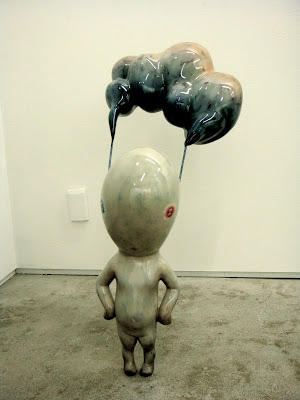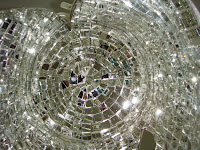
The following posting is by Anna Sakagawa, my guest blogger. (I am presently away from Tokyo, and will resume posting in mid-January).
Chim↑Pom latest group exhibition “Good to Be a Mummy” features three of their favorite artists. This exhibition could be seen as a spin-off to their previous solo show, “Good to Be Human,” that presented a “Kurukuru Party,” an installation reproducing a drunken night, and “Making of Sokushibutsu,” in which Motomu Inaoka, a member of Chim↑Pom, imitated the traditional Buddhist practice of Sokushibutsu, or “living Buddha.” The “Good to Be Human” exhibition was based on a paradox, clashing asceticism and gluttony.
This time around Chim↑Pom invited Yasuyuki Nishio, Sachiko Kazama, and Yoshimitsu Umekawa, askeding them to create something that is Chim↑Pom-inspired. In the artist talk that inagurated the exhibition, the leader of Chim↑Pom, Ryuta Ushiro explained that the group chose these three artists because they all share a common interest in Japanese monsters, and because they all understand the very purpose of Chim↑Pom’s art: “to play joke as seriously as possible.”
When the viewers enter the gallery they are confronted by a jaw-droppingly realistic sculpture of a “living Buddha” created by Nishio. The green-grey color of skin tissue resembles zombies or the undead from a Hollywood horror movie, yet the facial expression of the sculpture is very calm, even serene, as if to claim that he has attained the true Buddhist enlightenment that is far from the secular world. Nishio explained that he had attempted to create something that is neither dead nor alive, because it is the process of dying that truly fascinates him.
On the wall of the room, is a tapestry like painting of a Japanese soldier by Kazama. The posture of the figure in the painting and his skinny body clearly are inspired by Chim↑Pom’s “Making of Sokushibutsu.” The framing part of the tapestry, Kazama explained, is made of “the real cloth used in WWII as the uniform of Japanese military,” which she bought on Yahoo Auction for 1500yen. She said, laughing, that she was too scared to even touch the cloth, as it may well be possessed with a fallen spirit of the war, until she realized that the deadline for this artwork was coming soon, and she just had to cut it to make the frame for the tapestry. The expression of the figure in the painting is very graceful and proud, which was a common quality of Japanese soldiers in WWII. According to Kazama, the work is also inspired by the actual Japanese soldiers who chose to die from starvation instead of fighting to survive.
Next to Kazama’s painting is a triptych of three photos of Inaoka taken by Umekawa. Umekawa decided to shoot Inaoka as a “meditating monk,” “gangsta rapper,” (who he works with as a professional photographer) and “Miminashi-Hoichi” (a famous character in a Japanese monster mythology, who learned the sacred Buddhist Sutra to repel the monsters, and wrote the Sutra all over his body only to have his ears eaten by the monsters because he had forgotten to write the Sutra on his ears.) Ushiro introduced Umekawa as a photographer “who takes everything as it looks in the real life,” to which Inaoka added: “But I did try to make my waist look as thin as possible during the photo shoot.”

The underlining principle shared by all three works was to treat very lightly the otherwise-deadly-serious subject matter, such as the Buddhist practice of “living Buddha.” In their last show Chim↑Pom remains faithful to its practice of shocking the viewers. By presenting very serious matters in a way that undermines their gravity, they force the viewers into considering life and death through laughter—an effect guaranteed to provoke a strong reaction.
P.S. For an even stronger effect, at the time of the first artist talk on December 18th the opening night crowd was treated to popcorn and Big Macs just as they looked at the icons of emaciation.
—Anna Sakagawa





























